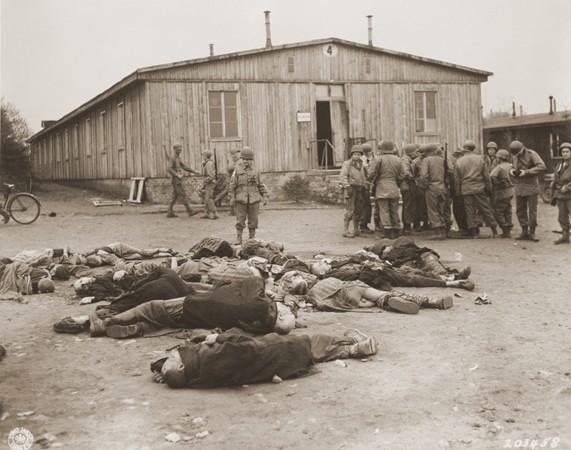
Ohrdruf
The Ohrdruf camp was a subcamp of the Buchenwald concentration camp, and the first Nazi camp liberated by US troops. The year 2025 marked the 80th anniversary of the liberation of concentration camps by US forces and the end of Nazi tyranny in Europe.
The Ohrdruf camp was created in November 1944 near the town of Gotha, Germany. Initially an independent site under the SS Main Economic and Administrative Office (SS-WVHA), it eventually became a sub-camp of Buchenwald. Ohrdruf supplied forced labor in the form of concentration camp prisoners for railway construction leading to a proposed communications center. Due to the rapid advance of US forces, the communications center was, however, never completed.
In late March 1945, the camp had a prisoner population of over 10,000 prisoners. In early April, the SS evacuated almost all the prisoners on death marches to Buchenwald. The SS guards killed many of the remaining prisoners who were too ill to walk to the railcars.
In early April 1945, units of the US 602nd Tank Destroyers’ Battalion, the 4th Armored Division, and 89th Infantry Division, entered the camp. When American soldiers entered the camp, they discovered the decomposing remains of hundreds of murdered prisoners, some covered with lime and others partially incinerated. They also encountered the camp’s surviving prisoners, starving, emaciated, and in need of medical attention.

The ghastly nature of their discovery led General Dwight D. Eisenhower, Supreme Commander of the Allied Forces in Europe, to visit the camp on April 12, with Generals George S. Patton and Omar Bradley. After his visit, Eisenhower cabled General George C. Marshall, the head of the Joint Chiefs of Staff in Washington, describing his trip to Ohrdruf:
. . .the most interesting—although horrible—sight that I encountered during the trip was a visit to a German internment camp near Gotha. The things I saw beggar description. While I was touring the camp I encountered three men who had been inmates and by one ruse or another had made their escape. I interviewed them through an interpreter. The visual evidence and the verbal testimony of starvation, cruelty and bestiality were so overpowering as to leave me a bit sick. In one room, where they were piled up twenty or thirty naked men, killed by starvation, George Patton would not even enter. He said that he would get sick if he did so. I made the visit deliberately, in order to be in position to give first-hand evidence of these things if ever, in the future, there develops a tendency to charge these allegations merely to “propaganda.”
Seeing the Nazi crimes committed at Ohrdruf made a powerful impact on Eisenhower, and he wanted the world to know what happened in the concentration camps. On April 19, 1945, he again cabled Marshall with a request to bring members of Congress and journalists to the newly liberated camps so that they could bring the horrible truth about Nazi atrocities to the American public. He wrote:
We continue to uncover German concentration camps for political prisoners in which conditions of indescribable horror prevail. I have visited one of these myself and I assure you that whatever has been printed on them to date has been understatement. If you could see any advantage in asking about a dozen leaders of Congress and a dozen prominent editors to make a short visit to this theater in a couple of C-54's, I will arrange to have them conducted to one of these places where the evidence of bestiality and cruelty is so overpowering as to leave no doubt in their minds about the normal practices of the Germans in these camps. I am hopeful that some British individuals in similar categories will visit the northern area to witness similar evidence of atrocity.
That same day, Marshall received permission from the Secretary of War, Henry Lewis Stimson, and President Harry S. Truman for these delegations to visit the liberated camps.
Ohrdruf made a powerful impression on General George S. Patton as well. He described it as “one of the most appalling sights that I have ever seen.” He recounted in his diary that
In a shed . . . was a pile of about 40 completely naked human bodies in the last stages of emaciation. These bodies were lightly sprinkled with lime, not for the purposes of destroying them, but for the purpose of removing the stench.
When the shed was full—I presume its capacity to be about 200, the bodies were taken to a pit a mile from the camp where they were buried. The inmates claimed that 3,000 men, who had been either shot in the head or who had died of starvation, had been so buried since the 1st of January.
When we began to approach with our troops, the Germans thought it expedient to remove the evidence of their crime. Therefore, they had some of the slaves exhume the bodies and place them on a mammoth griddle composed of 60-centimeter railway tracks laid on brick foundations. They poured pitch on the bodies and then built a fire of pinewood and coal under them. They were not very successful in their operations because there was a pile of human bones, skulls, charred torsos on or under the griddle which must have accounted for many hundreds.
The discovery of the Ohrdruf camp opened the eyes of many US soldiers to the horrors perpetrated by the Nazis during the Holocaust.
Critical Thinking Questions
What challenges did Allied forces face when they encountered the camps?
Did the outside world have any knowledge about the camps? If so, what actions, if any, were taken by other governments and their officials?
Why are firsthand accounts of mass atrocity important?

